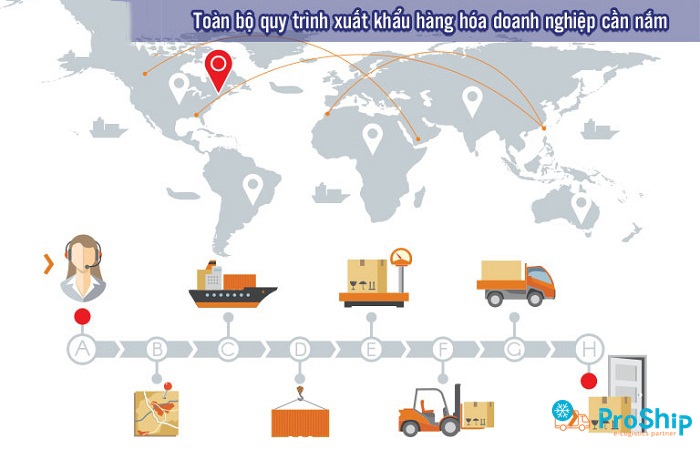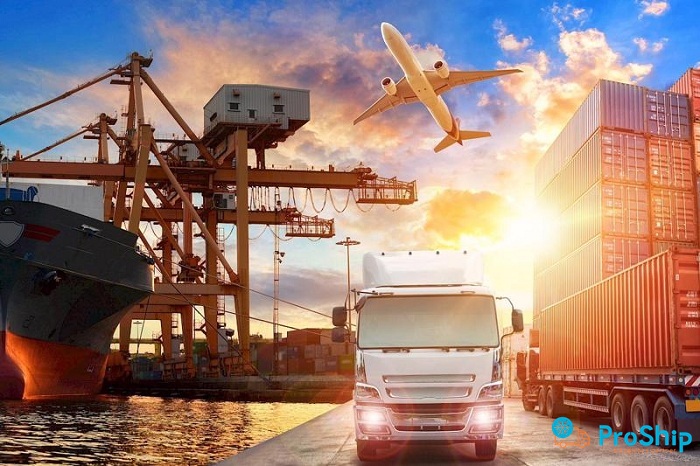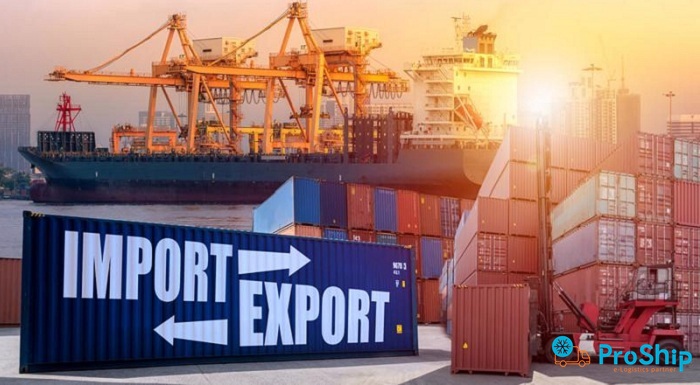x Does your business need to export goods abroad but have difficulty completing procedures and paperwork?
x Have you ever used the import-export and customs declaration services of another unit but did not feel secure and the prices were high?
x Do you want to find a unit that specializes in shipping exported goods abroad, with support for affordable, professional and responsible customs clearance procedures?
To ensure that export activities are carried out safely and smoothly, each import-export enterprise is required to carry out a professional export process and have a close connection between relevant parties. Below, Proship.vn will share details about the process of exporting goods, current forms of exporting goods in Vietnam and a few notes when exporting goods to foreign countries. At the same time, we also point out our unit's strengths in goods import and export services. Interested customers should update the content below.
📦 Hotline contact shipping
🧭 Central
What are the main forms of export in Vietnam today?
After understanding what exporting goods is, let's learn about the main forms that are popular in Vietnam. Accordingly, there are 6 main forms of exporting goods, including:
Direct export
It is a form of export where the seller and buyer directly exchange and sign foreign trade contracts with each other. This contract must comply with the laws of both countries and meet the standards of international sales regulations. The advantage of this form is that businesses can freely find trading partners, decide selling prices, payment methods... as long as they are within the framework of the State's policies. Therefore, large, reputable export enterprises with professional teams often choose this form.
Indirect export (entrusted)
In this form, businesses do not directly communicate with partners, but through intermediaries. This unit will receive authorization from your business and send goods abroad. Small businesses that do not have much experience in international trade, or do not have a specialized team, should export in this form. They only need to make an entrustment contract with an intermediary unit to take care of export procedures on their behalf.
Processing export goods
With this form, domestic enterprises will receive materials such as machinery, equipment, materials... from foreign companies and produce them. After completion, the goods will be exported as specified by the ordering company. This form of export is quite popular in our country. Possessing young, abundant, and cheap human resources is one of the reasons why many large businesses in other countries come to place orders.
Export at site
When exporting in this form, businesses do not need to worry about export procedures, because the seller will come to Vietnam to pick up the goods. This will be within the agreement of both parties, and the seller is willing to come to the place to receive the goods. Maybe because they want to personally inspect the goods before importing them. In return, domestic businesses will also be able to reduce many costs such as renting delivery containers, buying insurance, import and export tax procedures...
Temporary export for re-import, temporary import for re-export
For temporary export and re-import, goods are temporarily exported to another country and then imported back. Temporary import for re-export is goods temporarily imported into Vietnam and then exported to another country.
Countertrade
This is a form of barter because the seller and buyer will both export and import. In particular, depending on the negotiation between the two sides, they will export their own goods and import goods from their partners, a win-win cooperation.
Proship updates the latest detailed export process for 2023
Currently, import and export activities in Vietnam are increasingly developing and making great strides. Vietnam is a potential market with high consumption demand, many import businesses have been established, serving as an important trade bridge, contributing to promoting the national economy. Therefore, understanding the import and export process of goods is really necessary. To avoid errors, the procedure for exporting goods abroad should be carried out according to the following steps:
Step 1: Apply for an export license
Previously, when Vietnamese businesses wanted to export goods abroad, they had to apply for an export license. However, according to the current Decision No. 57/1998/ND/CP, all enterprises have the right to export goods in accordance with their domestic business registration content without having to apply for a business license. export (except for some items with separate management mechanisms such as: Rice, collectibles and antiques, works of art, explosives, books, gems, pearls).
Step 2: Sign the contract, prepare goods for export abroad
After obtaining a license, the next step in guiding procedures for exporting goods abroad is to sign a contract with a foreign enterprise, then quickly collect the goods to make an export shipment and Carry out packaging and marking to distinguish the goods.
Step 3: Buy insurance for goods
When transporting exported goods abroad, risks and losses are unavoidable. Therefore, you need to buy insurance for exported goods to best ensure the safety of your goods. Currently, you can easily buy insurance for exported goods at insurance companies.
Step 4: Rent a means of transportation
When renting a means of transportation, you need to consider the following factors:
- Based on the terms in the Goods Export Contract such as delivery conditions, quantity, etc.;
- Based on the characteristics of exported goods: What type of goods, what volume, size, storage conditions, etc.;
- Based on transport conditions: you need to determine whether the goods exported abroad are general or special goods, bulk goods or containerized goods. One-way or two-way transport, transport on normal or special routes, continuous transport or trip transport,...
From there, you can choose the appropriate means of transport, be it by road, sea, rail or air.
Step 5: Do customs procedures
Carrying out customs procedures for import and export of goods abroad is one of the mandatory regulations for all types of goods. The steps for customs clearance are as follows:
- Customs declaration: You are responsible for fully and honestly declaring the goods in the customs declaration so that the customs authority can check accordingly;
- Presenting the goods: You need to arrange the goods in an order that is most convenient in controlling and presenting the goods;
- Implement further decisions of the Customs Authority.

Step 6: Deliver goods to ship
When carrying out procedures to export goods abroad by sea, you need to pay attention to the following:
- Based on detailed information of the goods, prepare a freight registration form, then hand it over to the carrier in exchange for a loading number.
- Discuss with the port's dispatch department to know the exact time of loading goods onto the ship.
- After delivering the goods to the ship, you receive a receipt from the mate in exchange for a bill of lading and make a shipping contract.
In case of carrying out procedures to export goods abroad delivered by container, you need to rent a container and make a detailed list of goods in the container if the quantity of goods does not fill one container (LCL). You need to make a "Transportation registration" with the transportation company. After registration is accepted, you proceed to deliver the goods to the carrier.
Step 7: Make payment procedures
Payment procedures are the final result of all transactions in export business.
* Note: Payment documents need to be prepared accurately and in accordance with the contract that both parties have made. After you have payment documents, you need to go to the bank to submit payment procedures.
As seen, procedures for exporting and importing goods abroad go through many complicated steps. Therefore, you need to be careful to avoid errors that affect work progress.
In 2023, in what cases will export tax and import tax be reduced? Exported and imported goods that are under the supervision of customs authorities according to the provisions of the Customs Law 2014 and guiding documents, if damaged or lost due to objective causes, are approved by the customs authority. If an organization has the authority to inspect and certify, it will receive a tax reduction (stipulated in Clause 1, Article 18 of the Law on Export Tax and Import Tax 2016). In cases where exported or imported goods are damaged or completely lost, no tax must be paid. Note, the tax reduction level is determined corresponding to the actual loss rate of the goods.
📦 Hotline contact shipping
🧭 Central
Important notes about the current goods export process
When exporting goods, in addition to noting that you need to prepare all the necessary documents and choose the appropriate shipping unit, each method of transportation will have its own notes. Below are some important notes in the goods export process you need to know:
For road: Time to transport goods by road depends greatly on weather conditions or time of transport. Accordingly, if goods are transported during peak occasions such as border congestion, holidays, etc., the time it takes for the goods to reach the importer will be longer than expected.
For airways
- Pay attention to the volume because the airline has very clear regulations on the volume of goods allowed to be transported.
- It is necessary to package exported goods in accordance with the airline's regulations.

For sea routes
- Shipping time by sea depends on weather conditions such as rain, storm, wind, etc. Therefore, it is necessary to consider the weather situation before transporting goods to avoid any risks and ensure that goods are transported according to the schedule. true to customer commitments.
- During the process of transporting goods by sea, the fact that ships stop at many ports in different countries is also affected by the legal policies of each country.
>>See more: Process of exporting handicrafts
Proship.vn – Safe, Cheap, Professional container transport of import and export goods
In recent years, Vietnam's import and export of goods has made strong progress in scale and speed. In 20 years (period 2002 - 2021), Vietnam's total import and export value of goods has reached 5,146 billion USD. In particular, in the 10 years from 2012 to 2021 alone, the total import and export value of our country reached 4,110 billion USD, nearly 4 times higher than the import and export of the previous 10 years combined. The demand for import and export of all kinds of goods from the market is also increasing, leading to the birth of various types of Transport and Logistics Companies,...
PROSHIP.VN is currently one of the leading quality and reputable import-export service companies in Ho Chi Minh City, Hanoi, and Da Nang areas. We specialize in providing Logistics import and export services in the global supply chain. Each of our services demonstrates our strengths and professionalism. With the strength of a team of staff with deep expertise in import-export and dedicated work. Proship confidently meets all import and export needs of current and future customers.

Proship accepts shipping of exported items to International and European destinations
- Fresh and frozen seafood of all kinds;
- Agricultural products (Coffee, cassava, rubber, pepper, fruits and vegetables,...);
- Functional foods, traditional medicine, traditional medicine, western medicine;
- Dry foods, canned and packaged foods;
- Personal luggage, fashion accessories, clothes, shoes, leather, handbags, hats, etc.;
- Letters, wedding invitations, records, papers, vouchers, invoices, books, all kinds of publications;
- Full containers of wooden furniture, interior and exterior decorations;
- Decorations, paintings, photos, statues of God and Buddha of all sizes;
- Food oils;
- Plastic beads and plastic products...;
- Cups, bowls, ceramics, etc.;
- All types of machinery, electronic components, and spare parts;
- Textiles and garment accessories;
- Construction materials, iron and steel for projects, works, etc.
Proship collects goods door-to-door in provinces, cities, and industrial parks in Vietnam
- South: Ho Chi Minh City; Dong Nai; Binh Phuoc; Binh Duong; Tay Ninh; Long An; BA Ria Vung Tau; Dong Thap; Tien Giang; An Giang; Ben tre; Vinh Long; Tra Vinh; Hau Giang; Kien Giang; Soc Trang; Bac Lieu; Ca Mau; Can Tho;
- Central region: Thanh Hoa; Nghe An; Ha Tinh; Quang Binh; Quang Tri; Hue; Danang; Quang Nam; Quang Ngai; Pacify; Phu Yen; Khanh Hoa; Ninh Thuan; Binh Thuan;
- North: Hanoi; Lao Cai; Yen Bai; Dien Bien; Peace; Lai Chau; Son La; Ha Giang; As tall as; Bac Kan; Lang Son; Tuyen Quang; Thai Nguyen; Phu-Tho; Bac Giang; Quang Ninh; Bac Ninh; Ha Nam; Hai Duong; Hai Phong; Hung Yen; Nam Dinh; Ninh Binh; Peaceful; Vinh Phuc;
- Central Highlands region: Kon Tum; Gia Lai; Dak Lak ; Dak Nong; Lam Dong;
- Or from large industrial parks in Vietnam: Phuoc Dong, Duc Hoa III, Nhon Hoi Binh Dinh, My Phuoc 3, Tan Khai, Minh Hung, Dong Xoai, Tan Phu Trung, Ham Kiem, Binh Thuan, Bau Xeo, Loc An - Binh Son, Giang Dien, An Tay, Bim Son, Long Duc, Du Long, An Hoa; Long Huong, Tam Diep II, Tram Vang, Cat Trinh, My Yen – Tan Buu – Long Hiep; Khanh Phu, Ba Thien 2, Nhon Hoa, Yen Phong II, Cong Hoa, Dong Anh, Soc Son, Long Khanh, Dau Giay, Tan Thanh,...and other large and small industrial parks and clusters stretching from North to South.
The cost of transporting exported goods depends on factors
- Goods to be transported: What types of goods need to be transported, and the characteristics of each type of goods?
- Quantity of goods to be transported: How many bales, how many tons and how many cubes?
- Shipping dimensions: Include Length x Width x Height?
- Shipping time: Provide estimated time to ship goods abroad?
- Place of receipt and delivery: Where do you provide the address for receipt and delivery? Do you require door-to-door delivery?
- Some other information: Loading and unloading fees for both departure and arrival ends, crane fees, picking up goods, VAT,...
The customers Proship wants to target
- Forwarding agent;
- Importing unit;
- Product supplier.
Methods of receiving and delivering goods at Proship
- Door to door delivery: All import and export transportation activities are handled by Proship. We will receive and deliver the goods at the requested address;
- Pick up at the door, deliver at the warehouse: Proship will send a vehicle to pick up the goods at the door, gather at the warehouse and transport to the warehouse near the delivery address. After that, the customer comes to the Proship warehouse to receive the goods;
- Receive at the warehouse, deliver to your door: You will deliver the goods to the Proship warehouse. After that, we carry out home delivery upon request;
- Receive at warehouse, deliver at warehouse: You will transport goods to Proship warehouse. Then, we will proceed with transportation to the Proship warehouse located close to the delivery address. After that, the customer will come to our warehouse to receive the goods.
Proship, with many years of experience in the field of import and export goods transportation, has updated details of the import and export process of goods in general as well as the export process of goods in particular with the latest application for 2023. Any business or individual interested in this knowledge should learn in advance to minimize any unnecessary shortcomings that delay trade plans and exchange of high-value products/goods. And when you need to use transportation services, import and export of goods by road, rail, or sea, please contact 0909 344 247 for direct advice.
